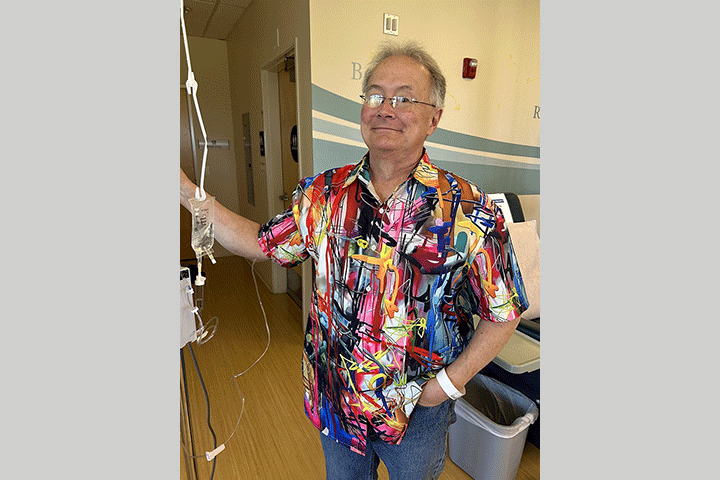Surveillance Improves Outcomes for High-Risk Patients

There’s good news for those at high risk of pancreatic cancer.
The majority of high-risk patients diagnosed with the disease while enrolled in a multidisciplinary surveillance program have stage I disease. Not only are these patients candidates for surgery—the only potential cure for the disease—but most are long-term survivors. The study found that more than 70 percent of patients were still alive five years later.
The research, dubbed The Cancer of the Pancreas Screening-5 (CAPS5) Study, which was published in June 2022 in the Journal of Clinical Oncology, found high-risk patients diagnosed with pancreatic cancer while enrolled in the CAPS surveillance program had a median survival of 9.8 years.
“When we started this [CAPS5], we didn’t know if surveillance was going to make a difference in terms of being of benefit to a patient,” says senior author Michael Goggins, M.B.B.Ch., M.D., the Sol Goldman Professor of Pancreatic Cancer Research and director of the Pancreatic Cancer Early Detection Laboratory at Johns Hopkins (Baltimore). “But what we see is that a very clear majority of patients who kept up with surveillance and then were diagnosed with pancreatic cancer had early stage disease. So to have patients be diagnosed at stage I when they can have surgery is a clear benefit since right now surgery is the only potential chance for long-term survival and for some maybe a cure. What we showed is that surveillance works.”
Although the pancreatic cancer survival rate now hovers around 11 percent, most patients are unfortunately still diagnosed at a later stage, which contributes to this poor survival rate. But largely due to improvements in imaging, a better understanding of the biology of the disease—leading to better, more tailored treatments for some patients—and enrollment of high-risk patients in surveillance programs, things are “incrementally improving,” adds Goggins. “We clearly need biomarkers for this disease so we can detect it earlier. And there is a lot of research going on in that area. Pancreatic cancer is very formidable, and it is also relatively rare. So having screening for everyone without symptoms or risk isn’t feasible or of benefit. But there is some significant work being done for multisite cancer tests, including one developed here at Hopkins. We need to see how that research plays out.
“We’ve been doing this for about 20 years, and there certainly have been improvements in all areas of pancreatic cancer research and treatment. We’ve got a ways to go, but what we can say is that according to our [CAPS] data, the outcomes for those diagnosed at stage I are dramatically different than being diagnosed at later stages.”
What the Study Shows
The goal of the current study was to describe outcomes of the multicenter CAPS5 study, which opened in 2014. The investigators then combined data from the CAPS5 study with those of the earlier CAPS1, CAPS2, CAPS 3, and CAPS4 screening studies, which ran between 1998 and 2014.
For the CAPS5 study, which took place between 2014 and 2021 at eight medical centers, 1,461 high-risk individuals were enrolled and provided with annual pancreatic imaging. Of these patients, 48.5% had a pathogenic variant in a PDAC susceptibility gene (18.4% with BRCA2 and 6.4% with an ATM variant), and around one third had a personal history of cancer, with breast cancer being the most commonly reported (15.8%).
Altogether, 10 patients were diagnosed with pancreatic cancer, including one who was diagnosed four years after dropping out of recommended surveillance.
Seven of the remaining nine patients (77.8%) were diagnosed with stage I disease. Of the two others, one had stage IIb disease and the other stage III disease.
Seven of the patients were alive at a median follow-up of 2.6 years.
Eight other participants had pancreatic surgeries for concerning lesions detected during surveillance, including three people with high-grade dysplasia (precancerous conditions) and five with low-grade dysplasia.
The CAPS study takes place in large medical centers. In the future, Goggins hopes the data will be compelling enough for smaller healthcare systems that can provide either MRIs or endoscopic ultrasounds to adopt high-risk pancreatic cancer screening efforts. “I think we would all like to see something like this adopted,” he says. “You really do need the right team of experts, though. Images can be difficult to read and interpret, and the last thing you want is for someone to go through an unnecessary surgical procedure.”
In this study, five patients underwent surgery after imaging showed abnormalities indicative of potential pancreatic cancer. However, the abnormalities were found to be low-grade precancerous only. “All screening carries a risk of a false positive or negative,” Goggins explains. “But for these patients, the surgery they go through to determine if some abnormality is actually cancer is not minor. It carries risks, too.”
Searching for Biomarkers
Significant research is underway in the pancreatic cancer scientific community to try to distinguish between normal biological processes in the pancreas and those that transform healthy cells into malignant ones. For example, scientists at the National Cancer Institute’s Early Detection Research Network and Pancreatic Cancer Detection Consortium have identified many candidate biomarkers, and research is ongoing to determine how these potential markers play out.
In pancreatic cancer, CA 19-9 is the most extensively studied biomarker to date. CA 19-9 is found on the surface of some but not all cancer cells, and it is also expressed in several noncancerous conditions, which can skew efforts in early detection. In addition, not every pancreatic cancer patient develops a high CA 19-9 level. CA 19-9 is currently used to determine how well a patient with pancreatic cancer is responding to treatment. But so far, it has not proven to be the most useful biomarker in early detection efforts.
Goggins and his colleagues hope to change that. In a study published in the journal Clinical Gastroenterology and Hepatology, the researchers obtained blood samples from 504 patients undergoing pancreatic surveillance from 2002 through 2018 who were enrolled in the CAPS5 study. These patients did not develop pancreatic cancer. Aside from measuring levels of CA 19-9, levels of CA-125 (used to monitor ovarian cancer) and CEA (carcinoembryonic antigen) were also measured. Common types of genetic variation among people are called single-nucleotide polymorphisms, or SNPs (pronounced “snips”). The researchers measured an array of SNPs that are associated with tumor marker levels. This allowed them to create a SNP-defined range for each tumor marker.
They tested this approach by measuring levels in blood samples from 245 patients who underwent resection for pancreatic cancer. However, the researchers determined that including information on the SNPs that are associated with levels of the markers CA 19-9, CEA, and CA-125 can improve the accuracy of using them for early detection.
The research is still ongoing, but the hope is that researchers can develop a blood test that can be used in high-risk patients as a kind of interval screen before they would be due for their annual imaging screens, Goggins explains. “It would be a simple blood test that maybe we could give high-risk patients, say, at six months before their next screening,” he says. “If we can pick up changes at that interval, then we might have even more improved outcomes.”






